
Guitar pedal power supply circuits come with all sorts of concerns, including:
- Reverse Polarity Protection
- Ripple Effects
- Radio Frequency (RF) Noise Injection
We saw how to deal with reverse polarity in Circuit 5: The Diode Protectors. The other two concerns involve common sources of noise in guitar effects design, and they can be addressed with a proper power supply filter.
[Last Updated: January 7, 2024]
As a member of the Reverb Partner Program and as an Amazon Associate, StompboxElectronics earns from, and is supported by, qualifying purchases.
Disclaimer: Stompbox Electronics and/or the author of this article is/are not responsible for any mishaps that occur as a result of applying this content.
How Pedals Are Powered
Powering from a Power Adapter
The electricity coursing through the walls of your home exists as Alternating Current, or AC.
The properties of that AC power vary from country to country. In America, power is delivered with a frequency of 60 Hz, while in Europe it’s 50Hz. The standard voltage for mains AC is 120VAC in America, while in Europe it’s 220VAC.
Those voltages are usually way too high for the components typically found in guitar pedals, so they need to be converted using a power conversion circuit.
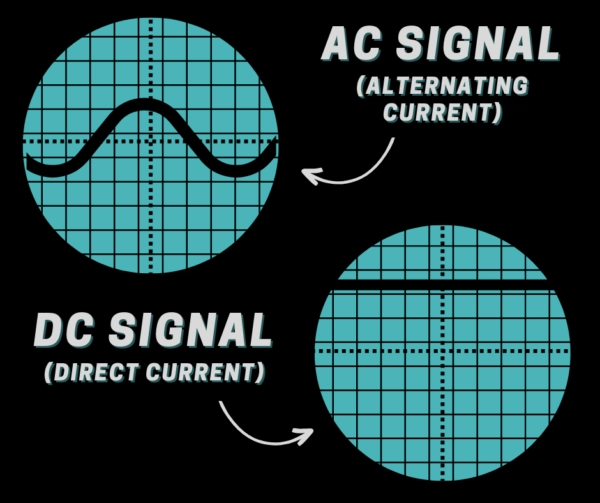
For example, the Line 6 DL-4 takes a 12VAC power supply (the Line 6 PX-2). Inside that power supply, there is a circuit that converts the 120VAC to the 12VAC required to run the DL-4.
Another example is the BOSS PSA-120S, which converts 120VAC to 9VDC. That 9VDC is the most common voltage level for powering guitar effects pedals.
Powering from Mains Voltage
Mains voltage refers to the voltage that appears at the wall outlet in your home. Some vintage pedals have a power cord that plugs directly into the wall outlet. A couple examples include the MXR Flanger 117 and the big box EHX Memory Man Deluxe.
These pedals internally convert the mains voltage into a fixed DC voltage. There are three steps:
- The mains voltage is applied to the primary side of a step-down transformer, resulting in a lower AC voltage on the secondary side.
- A rectification circuit converts the lower AC voltage into a manageable DC voltage.
- Smoothing and regulation stages are applied to the DC voltage, resulting in a steady DC voltage for the guitar pedal’s components (usually between 9-18VDC).
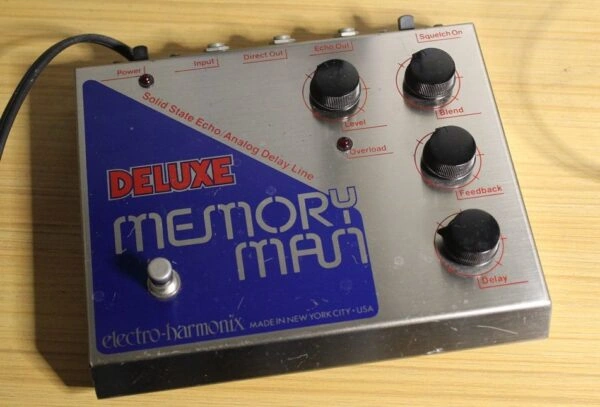
Typical Power Supply Circuits
The process for converting AC to DC voltage involves three main steps.
- “Step-down” the AC mains voltage to a lower voltage using a transformer.
- Rectify the resulting AC voltage to obtain a positive signal (either half-wave or full-wave recitifed, depending on the circuit).
- Run the rectified signal through a filter capacitor to stabilize the DC voltage.
Most of these steps are taken care of by your power adapter, but I’ve detailed them below for your general knowledge.
Step 1: Step-Down Transformation
First, 120VAC is stepped down to a lower, more manageable AC voltage. Transformers have a property called turns ratio that dictates how much the voltage is stepped down.
In the example circuit below, a turns ratio of 10:1 reduces the 120VAC to 12VAC.
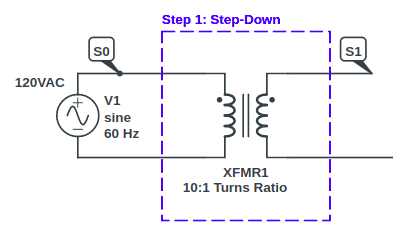
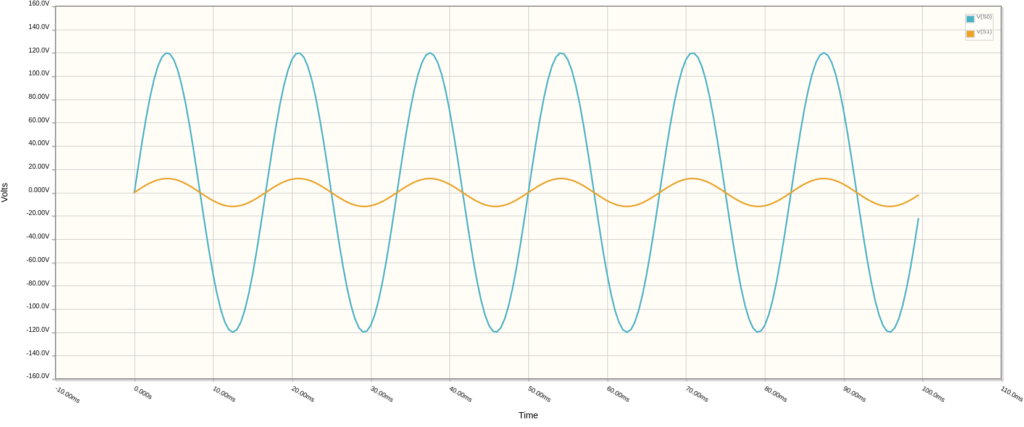
Step 2: Rectification
All we’ve done up to this point is convert an AC voltage into a lower AC voltage. The goal here is to achieve a constant DC voltage.
The rectification step deals with the negative-going part of the AC signal to either remove it entirely (half-wave rectification) or flip it over into positive territory (full-wave rectification). Our example circuit utilizes four ideal diodes, set up for full-wave rectification.
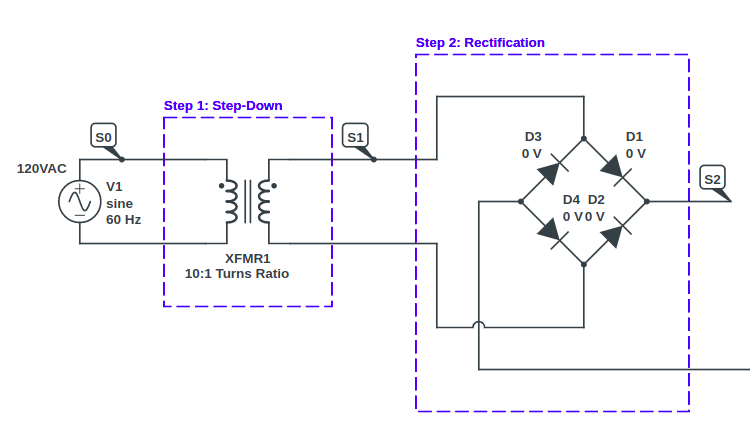
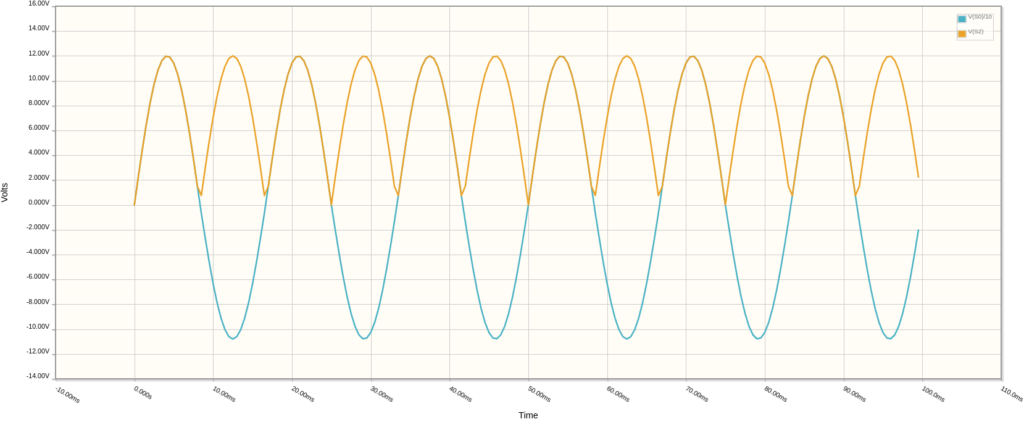
Step 3: Smoothing
Now that the entire power signal is in positive territory we need to smooth it out to obtain a constant DC voltage.
Typically, we use a smoothing capacitor for this. As the voltage increases across the capacitor plates, charge is stored to keep up with the voltage increase.
When the voltage across the plates starts to decrease, the capacitor starts to discharge.
The trick here is to choose a capacitor value large enough such that the time it takes for the cap to discharge is far greater than the time it takes for the voltage to start increasing again.
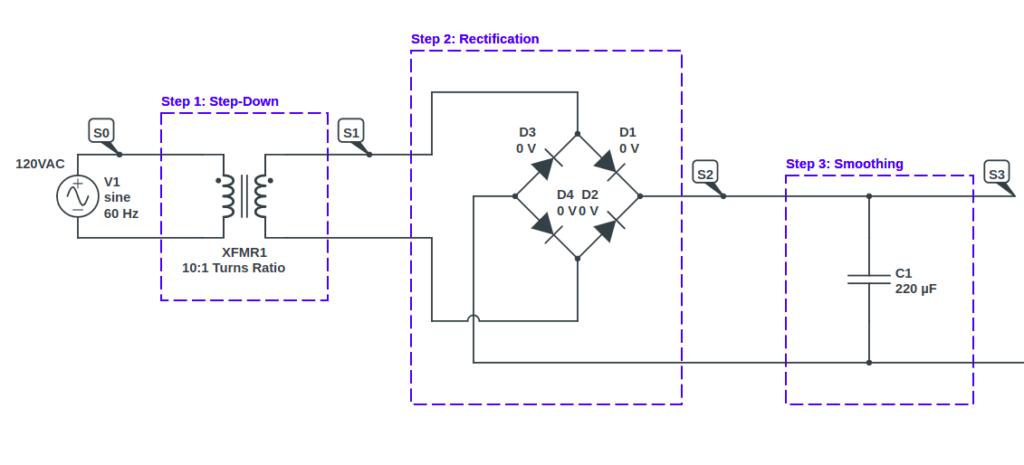
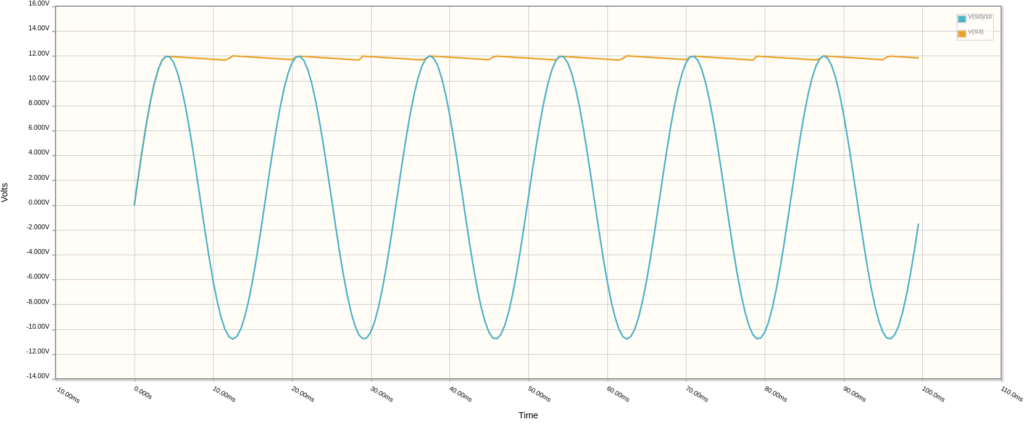
Ripple and 60-Cycle Hum
Notice how a small ripple has formed on the orange trace. That ripple can be a common source of what is typically called 60-cycle hum.
If you’re experiencing this hum, the first part you’d want to check would be a capacitor located across the power supply line (like the smoothing capacitor in the power adapter, or a capacitor placed across the power terminals inside the pedal).
Step 4: Regulation (Optional)
By now, the DC power signal has reached our pedal. The ripple voltage, if any, will be filtered away with a proper power supply filter circuit, as we’ll soon see.
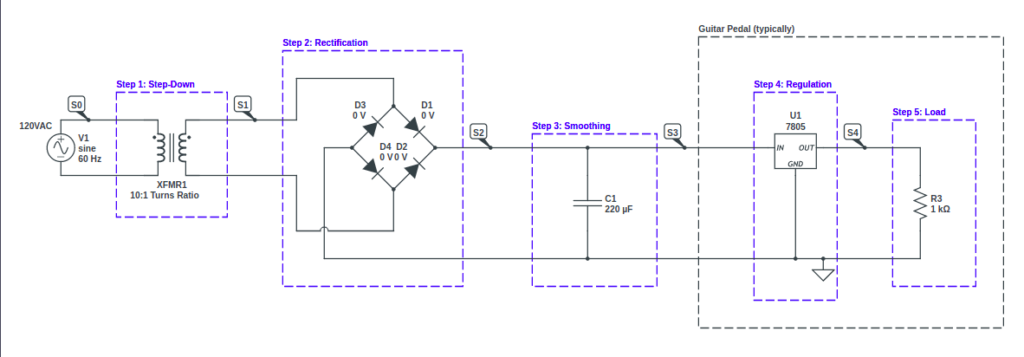
For completeness, I’ve added a fourth step to the power supply circuit: regulation.
Regulation serves to decrease the DC voltage and keep it steady for a given load. Most guitar pedals do not require this step, because wall-wart power supplies designed for guitar pedals are usually built with the operating voltage in mind (9V, 12V, 18V, etc.).
That said, there are times when you may need to regulate a voltage to a lower level (like 5V for digital components). For that, voltage regulation is used. The most common voltage regulators are the 78xx series group of regulators.
The Power Supply Filter Circuit
Let’s introduce the first version of the power supply filter in Figure 6.7.
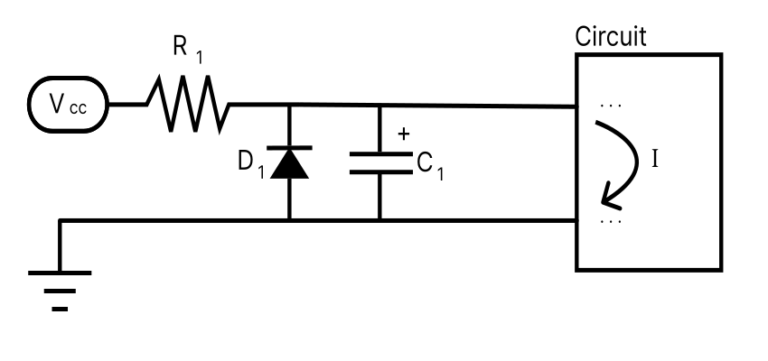
If you’re coming from Circuit 5 you’ll recognize the reverse polarity protection diode D1. In addition to D1, two components were added: R1 and C1.
The resistor R1 and capacitor C1 form an RC passive low-pass filter, which is a circuit covered more thoroughly later in this series. For now, you just need to understand that this circuit “filters out” the ripple voltage we saw in Figure 6.5.
Choosing R1 and C1
Generally, you’ll want to choose R1 and C1 so Equation 6.1 is satisfied:

The most important frequencies to filter out are in the 50-60Hz range, commonly found on mains power lines. Because of this, we want to make certain that we set our low-pass cut-off frequency to at most 50 Hz.
The resistor R1 is chosen to be as low as possible (let’s choose 47 ohms). To be fully certain we are cutting off the 60-cycle hum, let’s set the frequency value to 30 Hz instead of 50 Hz. With that in mind, solving for the capacitance value gives us approximately 100uF (Figure 6.8).
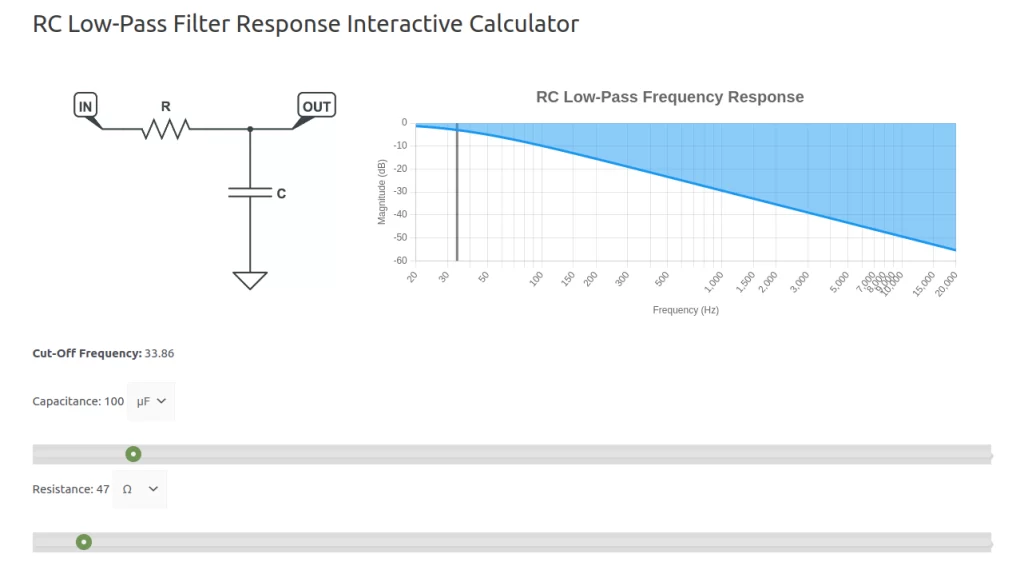
Employing the power supply circuit with R1 at 47 ohms and C1 at 100uF gives us the orange waveform in Figure 6.9:
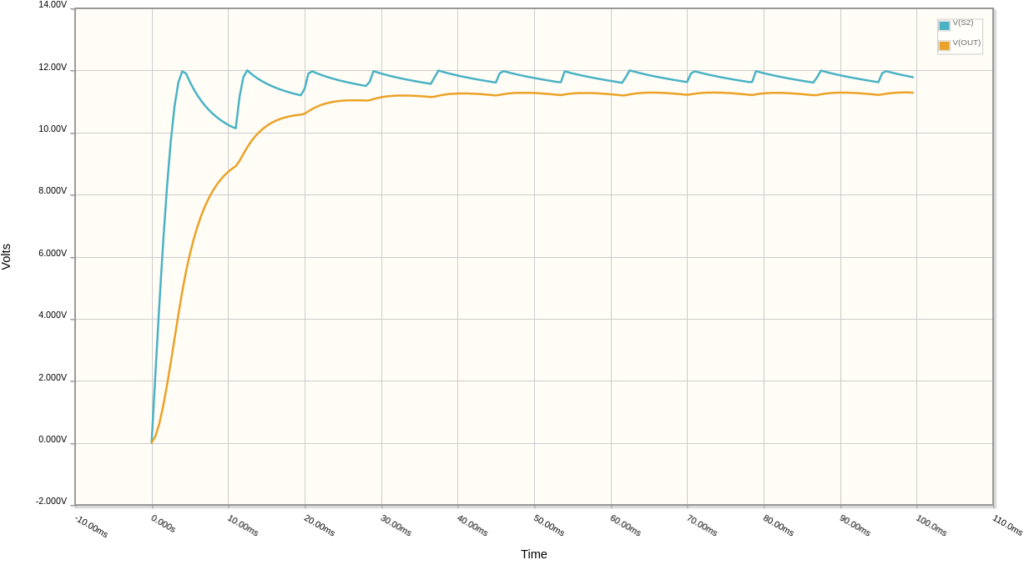
Dealing with RF Injection
One potential problem remains – radio-frequency (RF) injection.
RF noise can enter through the power supply and introduce unwanted noise, interfere with the way semiconductors operate, and travel through our circuit to other pedals through the input/output jacks.
You may be thinking “But we just added a low-pass filter…shouldn’t that bleed out all frequencies higher than 60Hz too?” Well, yes but not really.
The problem lies with a capacitor parameter called Equivalent Series Inductance (ESL) [2]. Basically, for capacitors with a high capacitance value, the ESL can lessen our circuit’s ability to filter out radio frequencies.
If we add another smaller-value capacitor in parallel with the existing cap, we can make up for that efficiency loss.
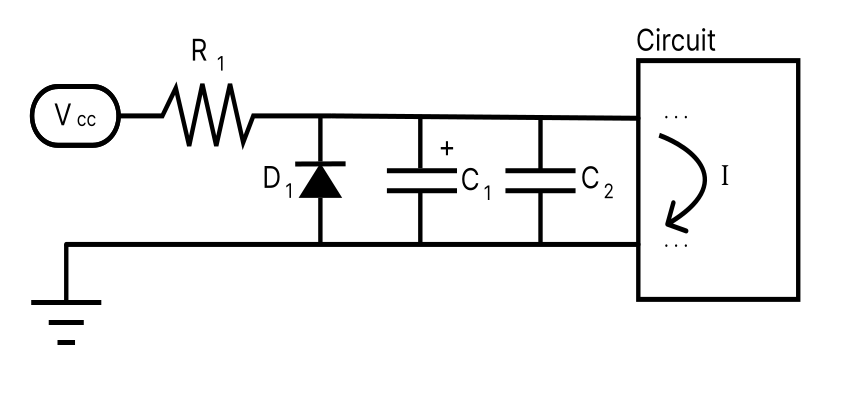
Adding C2 allows for a more efficient circuit for filtering out RF content. Notice there is no ‘+’ symbol on C2. This is because lower-value capacitors generally do not have a polarity.
Choosing C2
You can calculate the new cutoff frequency using Equation 6.2:

Power Supply Filter Parts List
You can build the power supply filter circuit in Figure 6.10 with just 4 parts:
| Parts | Qty |
|---|---|
| 1N4001 Diode | 1 |
| 100nF Poly Cap | 1 |
| 100uF Electrolytic Cap | 1 |
| 47 ohm Resistor, 1/2W | 1 |
Resources
[1] RC Low Pass Filter Response Interactive Tool
[2] The Complete Low ESL Capacitor Guide, Octopart May 5, 2022.
Guitar Effects Design in 48 Circuits or Less
The 48 Circuits or Less article series serves to close the gap between DIY guitar effects design and guitarists interested in the craft by uniquely curating the most important aspects of DIY guitar effect circuit design. This post is part of the 48 Circuits or Less series. View more articles in this series here.
Meet the Author:

Hi, I’m Dominic. By day, I’m an engineer. By night, I repair and modify guitar effects! Since 2017, I’ve been independently modifying and repairing guitar effects and audio equipment under Mimmotronics Effects in Western New York. After coming out with a series of guitar effects development boards, I decided the next step is to support that community through content on what I’ve learned through the years. Writing about electronics gives me great joy, particularly because I love seeing what others do with the knowledge they gain about guitar effects and audio circuits. Feel free to reach out using the contact form!
The Tools I Use
As a member of Amazon Associates, Stompbox Electronics earns and is supported by qualifying purchases.

















